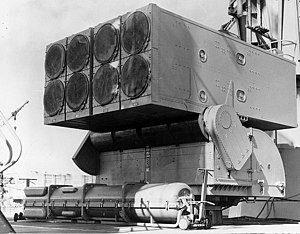ASROC
| RUR-5 ASROC | |
|---|---|

ASROC Launcher on board USS Columbus (1962)
|
|
| Type | Standoff anti-submarine ballistic missile |
| Place of origin | United States |
| Service history | |
| In service | 1961 |
| Used by | United States Navy and others |
| Production history | |
| Designer | Naval Ordnance Test Station Pasadena Honeywell |
| Manufacturer | Honeywell |
| Unit cost | Approximately $350,000 (not including warhead) |
| Specifications | |
| Weight | 1,073 pounds (487 kg) |
| Length | 14.75 ft (4.50 m) |
| Diameter | 16.6 inches (420 mm) |
| Warhead | Mark 46 torpedo, 96.8 pounds (43.9 kg) of PBXN-103 high explosive; 10kt W44 Nuclear Warhead (Retired) |
|
Detonation
mechanism |
Payload Specific |
|
|
|
| Engine | Solid propellant rocket motor |
| Wingspan | 26 7⁄8 inches (680 mm) |
|
Operational
range |
12 mi (19 km) |
| Speed | Subsonic |
|
Launch
platform |
Surface ships |
The RUR-5 ASROC (for "Anti-Submarine ROCket") is an all-weather, all sea-conditions anti-submarine missile system. Developed by the United States Navy in the 1950s, it was deployed in the 1960s, updated in the 1990s, and eventually installed on over 200 USN surface ships, specifically cruisers, destroyers, and frigates. The ASROC has been deployed on scores of warships of many other navies, including Canada, Germany, Italy, Japan, the Republic of China, Greece, Pakistan and others.
ASROC started development as the Rocket Assisted Torpedo (RAT) program by the Naval Ordnance Test Station at China Lake in the early 1950s to develop a surface warship ASW weapon counter to the new post-World War II submarines which ran quieter, at much higher speed and could attack from much longer range with high speed homing torpedoes. In addition, the goal was to take advantage of modern sonars with a much larger detection range. An extended range torpedo delivered by parachute from the air would allow warships the stand-off capability to attack hostile submarines with very little advance notice to the hostile submarine. The RAT program came in three phases: RAT-A, RAT-B and RAT-C. RAT-A (and its follow-on, RAT-B) were efforts to develop a compact and economical stand-off ASW for smaller warships, but were found to be either unreliable or had too short a range. RAT-C was a program to develop a stand-off ASW weapon that used a nuclear depth charge. This would require a range of at least 8,000 yards to escape potential damage from the underwater blast. Unlike the original RAT program rockets, the RAT-C was considerably larger to accomplish the extended range needed and was to be fitted to larger warships. With the failure of both the RAT-A and RAT-B programs, RAT-C was redesigned from a stand-off nuclear ASW weapon to one that could use not only a nuclear depth charge but also a homing ASW torpedo. To obtain the accuracy needed, the RAT-C rocket launcher had to be redesigned with larger side fins. This program finally combined reliability and accuracy, along with the necessary stand-off range. However, before RAT-C reached initial operational status in 1960 aboard the large US Navy destroyer leader USS Norfolk, its name was changed to the present ASROC.
The first ASROC system using the MK-112 "Matchbox" launcher, was developed in the 1950s and installed in the 1960s. This system was phased out in the 1990s and replaced with the RUM-139 Vertical Launch ASROC, or "VLA".
...
Wikipedia
